
The katipō is an endangered species of spider native to New Zealand. It is one of many species in the genus Latrodectus, such as the Australian redback, and the North American black widow. The species is venomous to humans, capable of delivering a potentially dangerous bite. It is a small to medium-sized spider, with the female having a round black or brown pea-sized body. Red katipō females found in the South Island and the lower half of the North Island, are always black, and their abdomen has a distinctive red stripe bordered in white. In black katipō females found in the upper half of the North Island, this stripe is absent, pale, yellow, or replaced with cream-coloured blotches. These two forms were previously thought to be separate species. The male is much smaller than the female and quite different in appearance: white with black stripes and red diamond-shaped markings. Katipō are mainly found living in sand dunes close to the seashore. They are found throughout most of coastal New Zealand except the far south and west. Katipō feed mainly on ground dwelling insects, caught in an irregular tangled web spun amongst dune plants or other debris.
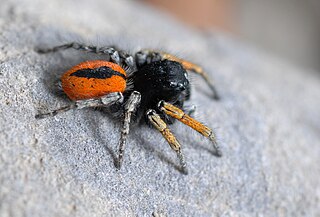
Philaeus chrysops is a species of jumping spider (Salticidae).

The Cordulegastridae are a family of Odonata (dragonflies) from the suborder Anisoptera. They are commonly known as spiketails. Some vernacular names for the species of this family are biddie and flying adder. They have large, brown or black bodies with yellow markings, and narrow unpatterned wings. Their bright eyes touch at a single point, and they can be found along small, clear, woodland streams, flying slowly 30 to 70 cm above the water. When disturbed, however, they can fly very rapidly. They usually hunt high in forest vegetation, and prefer to capture prey resting on leaves or branches.

Araniella cucurbitina, sometimes called the "cucumber green spider", is a spider of the family Araneidae. Araniella cucurbitina is found across Europe, Western Asia, Central Asia and Japan. The cucurbitina in the name comes from the word cucurbit which is a family of plants including cucumbers.

Micrathena, known as spiny orbweavers, is a genus of orb-weaver spiders first described by Carl Jakob Sundevall in 1833. Micrathena contains more than a hundred species, most of them Neotropical woodland-dwelling species. The name is derived from the Greek "micro", meaning "small", and the goddess Athena.

Maevia inclemens or the dimorphic jumping spider is a relatively common and colorful jumping spider of North America. In the males there are two forms, a very rare phenomenon in zoology. These use different courting displays, and differ in appearance: the "tufted" morph has a black body and pedipalps ("palps"), three black tufts across its "head", and pale legs; and the "gray" morph has black and white stripes all over its body and legs, orange palps, and no tufts. However, each form accounts for 50% of the adult males, and they are equally successful in mating. A female of Maevia inclemens is 6.5 to 8.0 millimetres long, while males are 4.75 to 6.50 millimetres long.

Zygoballus sexpunctatus is a species of jumping spider which occurs in the southeastern United States where it can be found in a variety of grassy habitats. Adult spiders measure between 3 and 4.5 mm in length. The cephalothorax and abdomen are bronze to black in color, with reddish brown or yellowish legs. The male has distinctive enlarged chelicerae and front femora. Like many jumping spiders, Z. sexpunctatus males exhibit ritualized courtship and agonistic behavior.

Neoscona domiciliorum, commonly known as the spotted orbweaver or redfemured spotted orbweaver, is a spider in the family Araneidae. The specific epithet domiciliorum means "of dwellings" in Latin and refers to the fact that this species is often found living on buildings. Their bites are not known to cause serious harm in humans.

Cyrtophora exanthematica are tent spiders common in tropical Asia and Australia. They are commonly known as double-tailed tent spiders because of the pair of blunt projections at the end of their abdomens. They are harmless to humans.

Araneus mitificus, commonly known as the kidney garden spider or pale orb weaver is a species of orb-weaver spider found in South, East, and Southeast Asia.
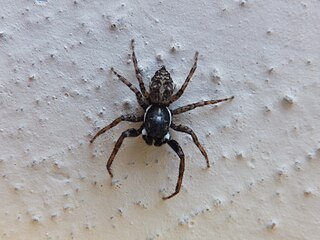
Menemerus guttatus is a species of jumping spider in the genus Menemerus that lives in Morocco. The spider has been found in the High Atlas mountains in gravel rivers. It displays complex courtship patterns. The species was first described in 1999 by Wanda Wesołowska, one of over 500 descriptions she has made during her lifetime. The spider is small, with a dark brown, nearly black carapace that is between 2.8 and 3.5 millimetres long and a dark brown abdomen between 2.5 and 5.6 millimetres long. The female is larger than the male. It can be distinguished from other species in the genus by the pattern on its abdomen, which consists of two lines of white patches that converge to the back of the spider. Otherwise, it is the copulatory organs that most identify the species. The male has a distinctive relatively wide and short embolus and lamella and two similar appendages at the base of the palpal bulb, or apophyses. The female has a complex internal structure of the epigyne including crescent-shaped chambers and circular spermathecae.

Menemerus minshullae is a species of jumping spider in the genus Menemerus that lives in South Africa, Malawi and Zimbabwe. The species was first described in 1999 by Wanda Wesołowska, one of over 500 descriptions she has completed during her lifetime. She originally identified the male as a different species, named Menemerus manicus, but merged the two in 2007. It is small to medium-sized spider with a cephalothorax that is between 1.9 and 2.2 millimetres long and an abdomen between 2.1 and 3.3 millimetres long. The female is larger than the male and lighter, with a dark brown rather than black carapace and lighter brown abdomen. The abdomen has a large, leaf-shaped, pattern. It lives on Vachellia xanthophloea trees, using its flattened shape to hide under flakes of bark. The copulatory organs distinguish the species from others in the genus. The male has a very short embolus with a larger accompanying conductor. The female epigyne has two pockets that have strongly sclerotized edges.
Rhene facilis is a species of jumping spider in the genus Rhene. The spider, spotted in South Africa and Tanzania, is small with distinctive female and male forms. The female is light brown, with grey and red hints, and has a distinctive epigyne. The male is darker in colour, with an almost black carapace and a dark brown abdomen with a white patterns, and has a slightly curved embolus. The male was first described in 2000 and the female in 2013.
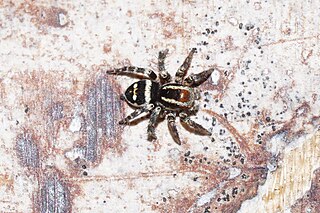
Stenaelurillus zambiensis is a species of jumping spider in the genus Stenaelurillus that lives in Malawi, Zambia and Zimbabwe. It was first described in 2014 by Wanda Wesołowska. The spider is small, the male being smaller than the female, with a brown carapace between 2.6 and 3.2 mm in length and black-brown abdomen between 2.6 and 3.0 mm in length. The male has a distinctive metallic sheen on its abdomen and eye field. The male carapace is marked with two white streaks while the female has white stripes. It is distinguished from other members of the genus by the male's hook-shaped end to the embolus and the two depressions in the female epigyne.
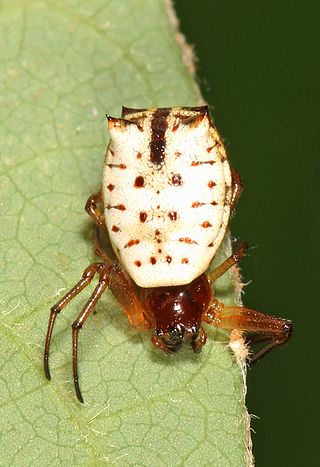
Micrathena mitrata, the white micrathena, is a species of orb weaver in the spider family Araneidae. It is found in a range from the United States to Brazil. The spider has a distinctive appearance with a shiny, black abdomen and spiky, yellowish-brown legs. Its body length ranges from 4 to 9 mm in females and 3 to 4 mm in males. The species is known for its elaborate web, which it uses to capture insects for food. Despite its fearsome appearance, Micrathena mitrata is not considered dangerous to humans and is generally regarded as a harmless spider.

Orestes subcylindricus is a species of stick insects native to Vietnam.
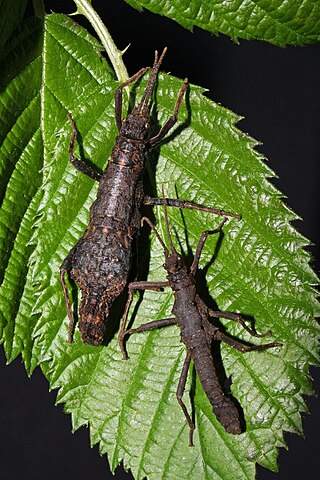
Dares murudensis is a relatively small species of stick insect. Like most other members of the genus Dares, the species is native to Borneo.
Micrathena yanomami is a species of orb-weaver spider described in 2011. Its distribution includes French Guiana, Brazil, and Peru. The species was first described by arachnologists Ivan Magalhães and Adalberto Santos.
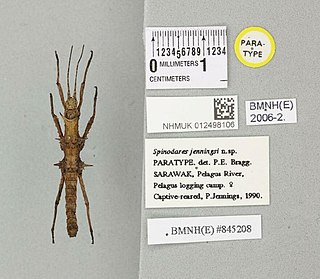
Spinodares is a monotypic stick insect genus endemic to Borneo, containing Spinodares jenningsi as the only valid species.
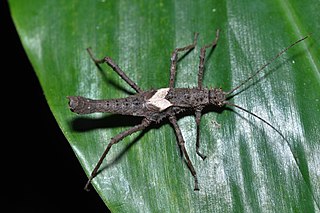
Haaniella parva is a species of stick insect from the subfamily Heteropteryginae and belongs to the representatives of the genus Haaniella native to Sumatra. It is their smallest representative.




















